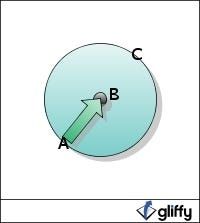Organisational Oversteer
I want to discuss Innovation and in particular, how you can destroy it very effectively in my next article, but before I do I need to explain my own concept (I should note at this point it’s probably not a unique concept, but it’s my own words and I haven’t read it anywhere — that’s not to say nobody else hasn’t already thought of or expressed it better) of Organisational Oversteer as this will come up a bit in future postings.It’s pretty simple.Â
Organisations will drive towards desireable behaviours by implementing Key Performance Indicators (KPI’s) which promote the change they are seeking. Once reaching the desired performance, they will proceed to overshoot the mark by failing to review the KPI’s which leads to over steer and a new set of undesireable behaviours.

Imagine the circle represents a sphere containing the range of cultural, management and other options available to you in your organisation today. For various reasons you decide you want to be centered around point B but are currently at point A. To move your organisation from A to B, you put in place a series of KPI’s and other measures which reward and motivate behaviours which will move you in the direction of the arrow, from point A to point B. What I believe typically then happens is that once point B has been reached (which may be a process of months or even years), instead of implementing a new stabilising set of KPI’s, the originals that moved us from A to B are left in place. These cause the organisation to over steer as it now moves from B towards C which is often as undesirable as A was in the first instance.This gradual change and realisation may take several years to achieve, during which time, the desirable point B has undoubtedly also moved within the circle in response to new pressures, at which point a new set of KPI’s and a new cycle of over steer begins.In fact it’s a no win situation! Organisations that find themselves at point B and then put in place a new set of measures, no longer compensating, but instead stabilising, also find over-time that even by merit of standing still, the desirable point B has shifted and they are now back at A again.I’m not proposing this as a bad or good thing. I see it more simply as something that just “is”, a fact of organisational operation that we need to deal with.  To turn this back to innovation then, I believe innovation is the driver that lets us change direction quickly as we attempt to stay on the “B” spot.
When the rate of change outside exceeds the rate of change inside, the end is in sight. Attributed to Jack Welch here.
Adapting to quickly to change through innovation and allowing it flourish will keep the organisation humming on the “B” spot. Failure to do so, and allowing organisational oversteer will see you floundering from point A to point C without adapting to the changes around you. More on this to come!
